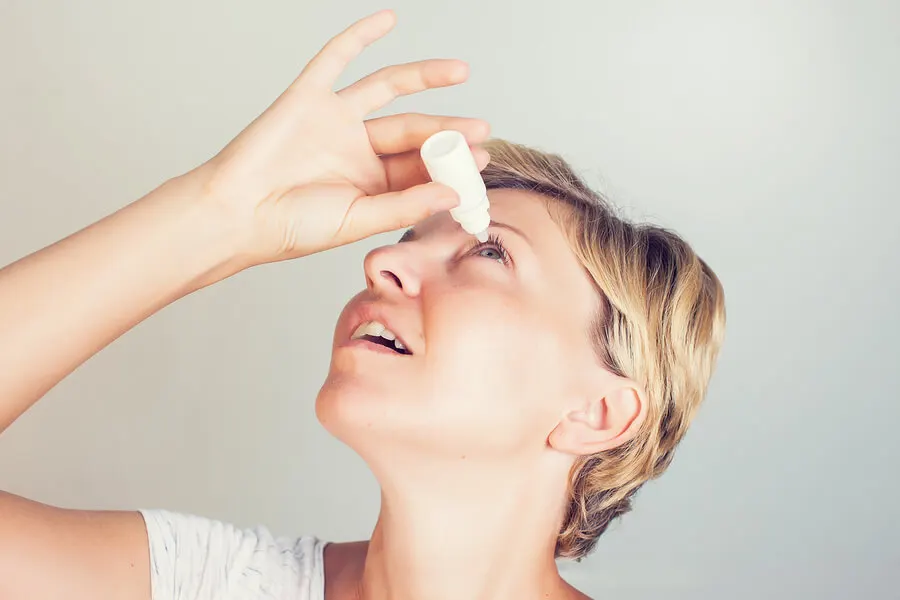7 Tips for Treating Eye Tic Disorder


Written and verified by the psychologist Bernardo Peña
If your eyelids tremble or close involuntarily, you may have a tic. This is a tremor that is often accompanied by vision problems or sensitivity to light and can occur repeatedly or in isolation. However, we will give you some advice to treat a nervous tic in the eye.
Nervous tics are very fine tremors of the muscles that can appear for multiple causes. Any striated muscle can be affected and their intensity is variable. Although they appear at any time, they are usually so slight that they go unnoticed by third parties.
If the tic is not serious, it can be improved or even disappear with some simple measures. Below, we’ll explain more about this peculiarity of the body scientifically called “blepharospasm” or eyelid spasm.
The causes of eye twitching
First of all, it’s important to try to identify the cause of this event. To do this, it will be essential to see an ophthalmologist to rule out any chronic disease. However, tics don’t have a specific cause in most cases.
Tics commonly appear, go away, or are modified on their own with the passage of time. A nervous tic in the eye can be triggered by different factors, from everyday situations to trauma.

According to a specialized publication of MedlinePlus, the most common causes of this problem are the following :
- Stress
- A sack of sleep
- Visual fatigue
- Consumption or abuse of toxic substances such as alcohol
- Excessive consumption of tobacco and caffeine
Certain nutritional deficiencies (such as a lack of magnesium, potassium and calcium, and vitamin B12), allergies, and diseases such as Sjögren’s syndrome can also be at the origin.
Likewise, a publication of the American Academy of Ophthalmology also states that a lack of hydration in the eye, blows to the area, and the use of medications for diseases such as Parkinson’s can also cause tics.
We think you may also enjoy reading this article: The Keys to Good Visual Hygiene for Preventing Eye Damage
Warning symptoms
If in addition to having involuntary twitching you experience dizziness or blurred vision, you should see a doctor as soon as possible, as this could be a sign of a more serious problem . Other considerable symptoms that demand immediate professional attention are:
- Drooping eyelids
- A headache
- Very slow blinking
- Tics that last weeks or even months
- Unusual discharge in the eye
- Irritation and swelling of the eye
Like this article? You may also like to read: Why Do we Find it Difficult to Maintain Eye Contact When Speaking?
Tips to relieve a nervous tic in the eye
When tics have an emotional origin, it’s a possibility to opt for natural treatments, as long as the professional approves and recommends them. It can be the case of therapeutic exercises, changes in your diet, or simply doing some physical activity.
It’s possible that your problem is temporary and does not require a prescription for psychotropic drugs. In such a case, you can follow the following tips to treat eye twitching.
1. Open and close your eyes tightly
To begin with, use force when blinking. Close your eyes as hard as you can, hold for 30 seconds and then open them with the same intensity. The eye will generate a tear that will help you moisturize, which could alleviate the dryness that, as we have already seen, is a possible factor causing the tic.
A much better alternative is to use lubricating eye drops. In the American Academy of Ophthalmology article mentioned above, this measure is suggested for the treatment of blepharospasm.
2. Massage the eye

A medical publication from Manual MSD details that another tip to calm a nervous tic in the eye is to touch your face or eyes. To do so, with the help of your fingertips, make circular movements on your eyelids for 20 seconds.
3. Blink
Something as simple as blinking several times in a row can reduce the discomfort caused by eye twitching. With this simple action, you can lubricate the eye naturally. Blinking rapidly can also be another tip to soothe the nervous eye tic.
4. Avoid stressful situations if you have an eye tic disorder
Stress and anxiety can also cause eye twitching. To avoid these problems, you need to take a break from all those nerve-wracking situations. Try to take it easy and, if you find it necessary, you can also seek professional help.
5. Get adequate rest and nutrition
The way you go about your days is key to preventing spasms. The medical publications referred to above talk about lack of sleep or poor rest as the cause of eye twitching.
To avoid this problem, don’t forget to sleep at least eight hours a day. In addition, as food and overall well-being are highly related, it is also positive to eat a balanced diet and drink enough water.
6. Avoid caffeine, alcohol, and tobacco
Another tip you can follow to alleviate a nervous tic in the eye is to avoid excesses. Caffeine, alcohol, and tobacco tend to cause multiple damages to the whole body when consumed excessively.
In this sense, reducing or avoiding all these substances could help to alleviate the problem. In turn, increasing the amount of daily exercise can help improve the overall health of the nervous system and combat tics.
7. Drops or cold compresses can help with an eye tic disorder

If your eyes feel dry, consult a specialist to prescribe drops or a special gel to moisturize them. You can also follow traditional medicine recipes and do it at home and apply water or chamomile compresses.
According to a study conducted by researchers at the University of Costa Rica, chamomile has properties to reduce inflammation and cause relief in the periocular area, that is, near the eyes.
However, keep in mind that it’s necessary to have the permission of an ophthalmologist before applying this popular recipe. To apply it, follow these steps:
- First, prepare an infusion with chamomile.
- Wait until it reaches a bearable temperature.
- Then, wash the area very well.
- Then, soak a compress in the infusion or in cold water.
- Then, apply it on closed eyes and wait a few seconds.
- Then repeat, but with the hot compress, also for a few seconds.
- Repeat as many times as your ophthalmologist recommends.
Eye tic disorder: Keep your eye doctor informed
In conclusion, if you have any of the above symptoms, one of the best tips for eye twitching is to see a specialist to prevent further damage. Avoid self-diagnosis and do not resort to self-medication.
Remember that this article is only a guide for you to try to improve the problem in a natural and simple way, but you should always have the guidance and supervision of a professional.
All cited sources were thoroughly reviewed by our team to ensure their quality, reliability, currency, and validity. The bibliography of this article was considered reliable and of academic or scientific accuracy.
- Lee AG, Burkat CN, Belinsky I, Marcet MM, Kedar S. Blepharospasm. American Academy of Ophthalmology Web site. Updated March 3, 2016. eyewiki.aao.org/Blepharospasm.
- Jiménez Delgado, Jefrey; Madrigal Rojas, José; Salazar Barrantes, Sofía. Tratamiento con Manzanilla (Matricaria chamomilla), para reducción de las ojeras. Revista Médica de la Universidad de Costa Rica. http://repositorio.ucr.ac.cr/handle/10669/12372
- Blefaroespasmo. MedlinePlus. https://medlineplus.gov/spanish/ency/article/000756.htm
- James Garrity. 2018. Blefaroespasmo. Manual MSD. https://www.msdmanuals.com/es/professional/trastornos-oft%C3%A1lmicos/trastornos-palpebrales-y-lagrimales/blefaroespasmo
This text is provided for informational purposes only and does not replace consultation with a professional. If in doubt, consult your specialist.








